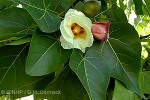Cook Islands Biodiversity Database
Species Page
Thespesia populnea
MiroPacific Rosewood
Multimedia & Additional Resources
| Type | Description | Download |
| Leaves, flower and fruit | 64KB | |
| Leaves, flowers & fruit (colour illlustration) | 38KB |
General Information
Cook Islands Distribution
| Southern Group: Present Makatea: Present | ||||||||
RR |
MG |
AT |
MK |
MT |
AK |
PL |
TK |
MN |
++ |
++ |
++ |
++ |
++ |
++ |
- |
||
| Northern Group: Present | |||||
TN |
MH |
RK |
PK |
NS |
SW |
++ |
+ |
X |
- |
- |
- |
Scientific Taxonomy
Thespesia populnea Linnaeus
SYNONYMS: Hibiscus populnea; Thespesia populnea acutiloba [of Africa]; Thespesia acutiloba [of Africa]
TAXONOMY: PLANTAE; ANTHOPHYTA (=Angiospermae); MAGNOLIOPSIDA (=Dicotyledones); DILLENIIDAE; Malvales; MALVACEAE
More Information
SIGNIFICANCE NOTES -
BIODIVERSITY: Locally endangered. Comment: NBSAP - Aitutaki (1= of 5 wild plants)
POSITIVE SIGNIFICANCE: Medicine, Ornamental ((Leaf/Flower)), Material (Wood). Comments: MATERIAL: One of the most popular carving woods in Polynesia. Miro is an oily, fine-grained, strong, hard, and durable wood. The dark-red heartwood and the white sapwood are equally hard. The dense oily wood enables a polished finish. Grows in short twists and turns and is ideal for small objects, such as food bowls and other artefacts.
GENERAL NOTE: A very widespread native tree from east Africa to Samoa. In the Cook Islands and French Polynesia, and in Hawaii, it might be native but could also have been a Polynesian Introduction for its excellent wood.
This tree was NOT named after Portia the heroic heiress and 'lady barrister' in Shakespeare's Merchant of Venice. Portia (hence Portia Tree) was derived from Tamil name puarassu, meaning "king-flower". Although not well known in the Pacific, Portia Tree is used widely in the English speaking world.
Vouchers & References
Vouchers:
None Recorded.
References:
p.902 Wagner et al.- Flowering Plants of Hawaii
p.563 Neal - In Gardens of Hawaii
p.1151 Royal Hort. Soc. Index of Garden Plants
p.628 Tropica
p.2/425 A.C.Smith - Flora Vitiensis Nova
p.274 I Cheeseman - Flora of Rarotonga
p.74 Wilder - Flora of Rarotonga
p.380c Whistler - Ethnobotany of the Cook Islands
Data Update History (information):
zTX, zB02, zM02
Web Resources
Citation Information
McCormack, Gerald (2007) Cook Islands Biodiversity Database, Version 2007.2. Cook Islands Natural Heritage Trust, Rarotonga. Online at http://cookislands.bishopmuseum.org. ![]()
Please refer to our use policy.

